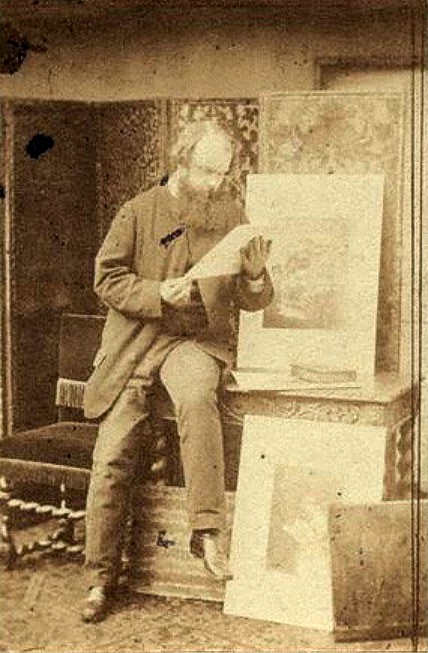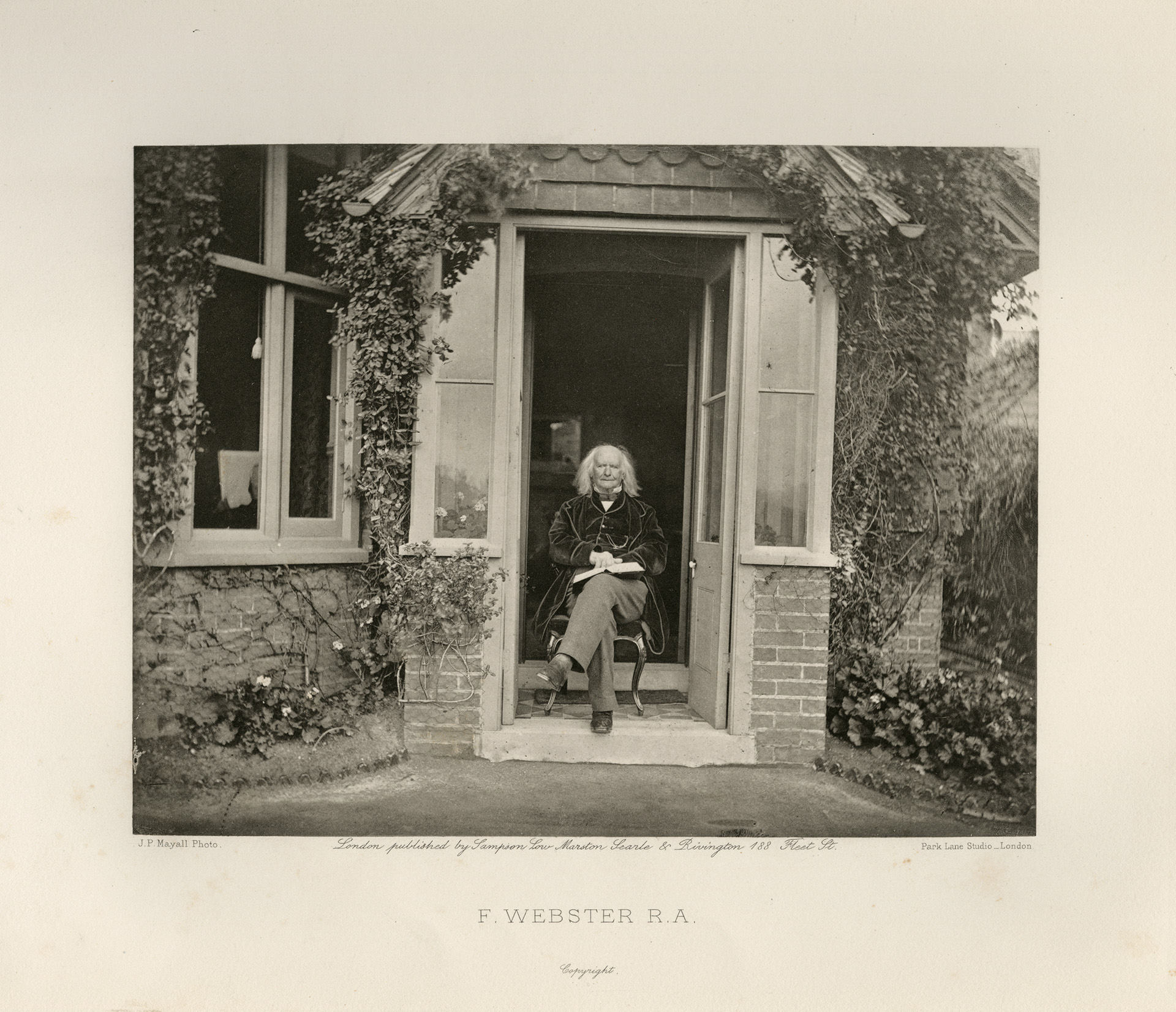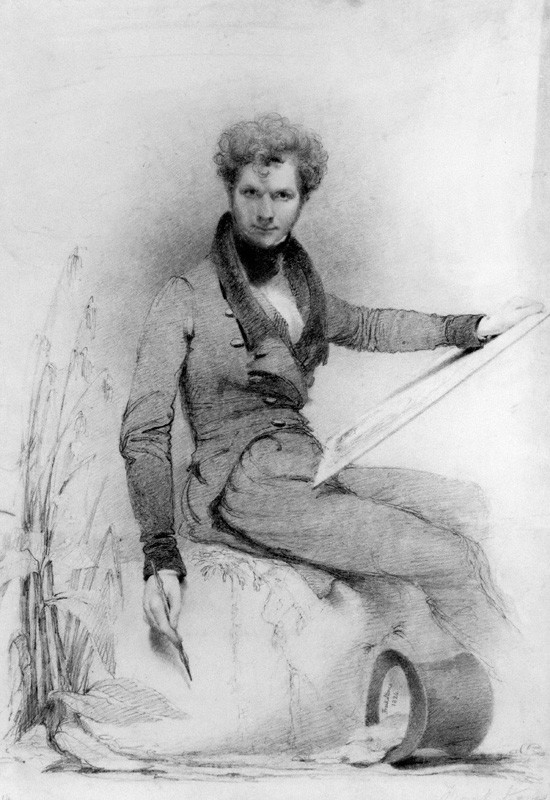|
The Etching Club
The Etching Club (also known as Etching Club, the London Etching Club, and the British Etching Club; or the Junior Etching Club for its younger membership grouped separately) was an artists' society founded in London, England, in 1838 by Charles West Cope. It was part of the Etching Revival in printmaking. The club published illustrated editions of works by authors such as Oliver Goldsmith, Shakespeare, John Milton and Thomas Gray in small editions, normally using actual etchings rather reproductions of them by other techniques. It effectively ceased to exist in 1878.Lang, p. 39. Membership *Richard Ansdell *Thomas Oldham Barlow *Charles West Cope (1811–1890) *Thomas Creswick * William Charles Thomas Dobson * Edwin Austin Forbes (1839–1895) (Honorary member) *William Edward Frost * Francis Seymour Haden *James Clarke Hook *John Callcott Horsley * William Henry Hunt *William Holman Hunt *John Everett Millais * George B. O'Neill *Samuel Palmer *Richard Redgrave (1804 ... [...More Info...] [...Related Items...] OR: [Wikipedia] [Google] [Baidu] |
Samuel Palmer - The Lonely Tower - Google Art Project (2397075)
Samuel is a figure who, in the narratives of the Hebrew Bible, plays a key role in the transition from the biblical judges to the United Kingdom of Israel under Saul, and again in the monarchy's transition from Saul to David. He is venerated as a prophet in Judaism, Christianity, and Islam. In addition to his role in the Bible, Samuel is mentioned in Jewish rabbinical literature, in the Christian New Testament, and in the second chapter of the Quran (although the text does not mention him by name). He is also treated in the fifth through seventh books of ''Antiquities of the Jews'', written by the Jewish scholar Josephus in the first century. He is first called "the Seer" in 1 Samuel 9:9. Biblical account Family Samuel's mother was Hannah and his father was Elkanah. Elkanah lived at Ramathaim in the district of Zuph. His genealogy is also found in a pedigree of the Kohathites (1 Chronicles 6:3–15) and in that of Heman the Ezrahite, apparently his grandson (1 Chronicles 6: ... [...More Info...] [...Related Items...] OR: [Wikipedia] [Google] [Baidu] |
James Clarke Hook
James Clarke Hook (21 November 1819 – 14 April 1907) was an England, English painting, painter and etching, etcher of Marine art, marine, genre#Visual arts, genre and History painting, historical scenes, and Landscape art, landscapes. Life Hook was born in London, the son of James Hook, a draper and one time Judge of the Mixed Commission Court in Sierra Leone. His mother was the second daughter of Bible scholar Adam Clarke, Dr Adam Clarke – hence the painter's second name. Young Hook's first taste of the sea was on board the Berwick-upon-Tweed, Berwick Smack (ship), smacks which took him on his way to Wooler. He drew with rare facility, and determined to become an artist, practiced his work, on his own initiative, for more than a year in the sculpture galleries of the British Museum. Still in his youth, he also had some advice by John Jackson (painter), John Jackson and John Constable. In 1836, Hook was admitted as a student to the Royal Academy, London, where he worked ... [...More Info...] [...Related Items...] OR: [Wikipedia] [Google] [Baidu] |
Bolton Corney
Bolton Corney (1784–1870) was an English army officer and official, known as a critic and antiquary. Life Corney was born at Greenwich on 28 April 1784, and baptised in the parish church of St. Alphage. He obtained in 1803 a commission as ensign in the 28th Foot. Later he was at Greenwich, where he held the post of first clerk in the steward's department at the Royal Hospital. He retired in 1845 or 1846, when he married, and moved to Barnes, Surrey, where he lived to his death on 30 August 1870, surrounded by his books. Corney was a member of the council of the Shakspere Society and the Camden Society, and an auditor of the Royal Literary Fund. He engaged in controversy with Anthony Panizzi of the British Museum. Works Corney's works were: * ''Researches and Conjectures on the Bayeux Tapestry'' reenwich, 1836 London 1838. He contended that the tapestry was not executed till 1205, and his view was adopted by John Lingard. Édouard Lambert (1794–1870) published a reply to C ... [...More Info...] [...Related Items...] OR: [Wikipedia] [Google] [Baidu] |
Joseph Cundall
Joseph Cundall (22 September 1818 – 10 January 1895) was a Victorian English writer under the pseudonym of "Stephen Percy", a pioneer photographer and London publisher of children's books. He provided employment for many of the best artists of the day by using them as illustrators. Joseph was the son of Eliza and Benjamin Cundall, a draper. He trained as a printer in Ipswich, and aged 16 found work in London with Charles Tilt, a bookseller and publisher. He wrote two books for Tilt and succeeded N Hailes in 1841 at the Juvenile Library, 12 Old Bond Street. In 1848 he started a lending library for children called St. George's Reading Library. In 1843 Cundall became publisher of the ''Home Treasury'' children's books, a series conceived and edited by Henry Cole under the pseudonym ''Felix Summerly''. Cole, who was later knighted, became the first director of South Kensington Museum which later changed its name to the Victoria and Albert Museum. In 1848, he transformed the antago ... [...More Info...] [...Related Items...] OR: [Wikipedia] [Google] [Baidu] |
Thomas Webster (painter)
Thomas Webster (10 March 180023 September 1886), was a British painter of genre works, genre scenes of school and village life, many of which became popular through prints. He lived for many years at the Cranbrook Colony, artists' colony at Cranbrook Colony, Cranbrook in Kent. Life Webster was born in Ranelagh Street, Pimlico, London. His father was a member of the household of George III of the United Kingdom, George III, and the son, having shown an aptitude for music, became a chorister, first at St. George's Chapel, Windsor Castle, St George's Chapel in Windsor Castle, and then the Chapel Royal at St. James's Palace in London. He abandoned music for painting, however, and in 1821 was admitted as a student at the Royal Academy, exhibiting, in 1824, a portrait of "Mr Robinson and Family". In the following year he won first prize in the school of painting. In 1825, also, Webster exhibited ''Rebels shooting a Prisoner'', at the Suffolk Street Gallery - the first of a series ... [...More Info...] [...Related Items...] OR: [Wikipedia] [Google] [Baidu] |
Henry James Townsend
Henry may refer to: People and fictional characters * Henry (given name), including lists of people and fictional characters * Henry (surname) * Henry, a stage name of François-Louis Henry (1786–1855), French baritone Arts and entertainment * ''Henry'' (2011 film), a Canadian short film * ''Henry'' (2015 film), a virtual reality film * '' Henry: Portrait of a Serial Killer'', a 1986 American crime film * ''Henry'' (comics), an American comic strip created in 1932 by Carl Anderson * "Henry", a song by New Riders of the Purple Sage Places Antarctica * Henry Bay, Wilkes Land Australia *Henry River (New South Wales) *Henry River (Western Australia) Canada * Henry Lake (Vancouver Island), British Columbia * Henry Lake (Halifax County), Nova Scotia * Henry Lake (District of Chester), Nova Scotia New Zealand * Lake Henry (New Zealand) * Henry River (New Zealand) United States * Henry, Illinois * Henry, Indiana * Henry, Nebraska * Henry, South Dakota * Henry County (disambigu ... [...More Info...] [...Related Items...] OR: [Wikipedia] [Google] [Baidu] |
John Frederick Tayler
(John) Frederick Tayler (30 April 1802England Births and Christenings, 1538–1975 at familysearch.org. Retrieved 19 October 2011 – 20 June 1889) was a 19th-century English landscape watercolour painter, and president of the . Personal Frederick was the son of a country gentleman, Archdale Wilson Tayler and his wife Frances Eliza, and was born at Boreham Wood, , Hertfordsh ...[...More Info...] [...Related Items...] OR: [Wikipedia] [Google] [Baidu] |
Frank Stone (painter)
Frank Stone (22 August 1800 – 18 November 1859) was an English painter. He was born in Manchester, and was entirely self-taught. Career He was elected an Associate of the Society of Painters in Water Colours in 1833 and Member in 1843; and an Associate of the Royal Academy in 1851. The works he first exhibited at the Academy were portraits, but from 1840 onwards he contributed figure pictures, scenes from Shakespeare, scripture and sentimental subjects, many of which were engraved. In 1850 he led the opposition within the Academy to the innovations of the Pre-Raphaelite Brotherhood, having already criticised their work in the previous year. When Dante Gabriel Rossetti wrote a very critical review of Stone's work in return, Stone launched an outright assault on Pre-Raphaelitism, initiating the controversy that engulfed the movement. Leading Pre-Raphaelite William Holman Hunt later depicted a print of one of Stone's works in the background of his painting ''The Awakening Consc ... [...More Info...] [...Related Items...] OR: [Wikipedia] [Google] [Baidu] |
Richard Redgrave
Richard Redgrave (30 April 1804 in Pimlico, London – 14 December 1888 in Kensington, London) was an English landscape artist, genre painter, and administrator. Early life He was born in Pimlico, London, at 2 Belgrave Terrace, the second son of William Redgrave, and younger brother of Samuel Redgrave. While employed in his father's manufacturing firm, he visited the British Museum to make drawings of the marble sculptures there. His work ''The River Brent, near Hanwell'' of 1825 saw him admitted to the Royal Academy schools the next year. He left his father's firm in 1830 and began to make a living teaching art.. Career He worked at first as a designer. He was elected an Associate in 1840 and an Academician in 1851 (retired, 1882). His ''Gulliver on the Farmer's Table'' (1837) made his reputation as a painter. He became an assiduous painter of landscape and genre; his best pictures being ''Country Cousins'' (1848), ''Olivia's Return to her Parents'' (1839), ''The Sempstr ... [...More Info...] [...Related Items...] OR: [Wikipedia] [Google] [Baidu] |
Samuel Palmer
Samuel Palmer Hon.RE (Hon. Fellow of the Society of Painter-Etchers) (27 January 180524 May 1881) was a British landscape painter, etcher and printmaker. He was also a prolific writer. Palmer was a key figure in Romanticism in Britain and produced visionary pastoral paintings. Early life Palmer, who was born in Surrey Square off the Old Kent Road in Newington, London (now Walworth), was the son of Samuel Palmer, a bookseller and sometime Baptist minister and Martha (nee Giles),"Mysterious Wisom" Rachel Campbell-Johnston book 2011 but was raised by a pious nurse, Mary Ward. Palmer painted churches from around age twelve, and first exhibited Turner-inspired works at the Royal Academy at the age of fourteen. He had little formal training, and little formal schooling, although he was educated briefly at Merchant Taylors' School. On the 18th January 1818 Palmer's mother Martha died suddenly, an event that affected the young Palmer for the rest of his life. He wrote "It was lik ... [...More Info...] [...Related Items...] OR: [Wikipedia] [Google] [Baidu] |
George B
George may refer to: Names * George (given name) * George (surname) People * George (singer), American-Canadian singer George Nozuka, known by the mononym George * George Papagheorghe, also known as Jorge / GEØRGE * George, stage name of Giorgio Moroder * George, son of Andrew I of Hungary Places South Africa * George, South Africa, a city ** George Airport United States * George, Iowa, a city * George, Missouri, a ghost town * George, Washington, a city * George County, Mississippi * George Air Force Base, a former U.S. Air Force base located in California Computing * George (algebraic compiler) also known as 'Laning and Zierler system', an algebraic compiler by Laning and Zierler in 1952 * GEORGE (computer), early computer built by Argonne National Laboratory in 1957 * GEORGE (operating system), a range of operating systems (George 1–4) for the ICT 1900 range of computers in the 1960s * GEORGE (programming language), an autocode system invented by Charles Le ... [...More Info...] [...Related Items...] OR: [Wikipedia] [Google] [Baidu] |
John Everett Millais
Sir John Everett Millais, 1st Baronet ( , ; 8 June 1829 – 13 August 1896) was an English painter and illustrator who was one of the founders of the Pre-Raphaelite Brotherhood. He was a child prodigy who, aged eleven, became the youngest student to enter the Royal Academy Schools. The Pre-Raphaelite Brotherhood was founded at his family home in London, at 83 Gower Street (now number 7). Millais became the most famous exponent of the style, his painting '' Christ in the House of His Parents'' (1849–50) generating considerable controversy, and he produced a picture that could serve as the embodiment of the historical and naturalist focus of the group, ''Ophelia'', in 1851–52. By the mid-1850s, Millais was moving away from the Pre-Raphaelite style to develop a new form of realism in his art. His later works were enormously successful, making Millais one of the wealthiest artists of his day, but some former admirers including William Morris saw this as a sell-out (Millais n ... [...More Info...] [...Related Items...] OR: [Wikipedia] [Google] [Baidu] |








